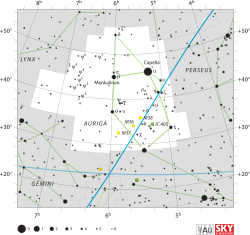|
| Psi3 Aurigae (ψ3) |  | Observationsdata
Epok: J2000.0 |
|---|
| Stjärnbild | Kusken |
|---|
| Rektascension | 06t 38m 49,18001s[1] |
|---|
| Deklination | +39° 54′ 09,2150″[1] |
|---|
Skenbar magnitud ( ) ) | +5,20[2] |
|---|
| Stjärntyp |
|---|
| Spektraltyp | B8 III[3] |
|---|
| U–B | -0,38[4] |
|---|
| B–V | -0,07[4] |
|---|
| Astrometri |
|---|
Radialhastighet ( ) ) | +9,0 ± 4,2[5] km/s |
|---|
| Egenrörelse (µ) | RA: -8,68[1] mas/år
Dek.: -11,61[1] mas/år |
|---|
Parallax ( ) ) | 2,38 ± 0,39[1] |
|---|
| Avstånd | 1 370 ± 20 lå (420 ± 5 pc) |
|---|
Absolut magnitud ( ) ) | -2,71[6] |
|---|
| Detaljer |
|---|
| Radie | 4,2[7] R☉ |
|---|
| Luminositet | 1 624[6] L☉ |
|---|
| Temperatur | 13 361 ± 83[8] K |
|---|
| Vinkelhastighet | 118[8] km/s |
|---|
| Andra beteckningar |
|---|
| ψ3 Aur, 52 Aurigae, BD+40° 1665, HD 47100, HIP 31789, HR 2420, SAO 59319 [9] |
Psi3 Aurigae (ψ3 Aurigae, förkortat Psi3 Aur, ψ3 Aur) som är stjärnans Bayerbeteckning, är en ensam stjärna[2] belägen i den mellersta delen av stjärnbilden Kusken. Den har en skenbar magnitud på 5,20[2] och är svagt synlig för blotta ögat där ljusföroreningar ej förekommer. Baserat på parallaxmätning inom Hipparcosuppdraget på ca 2,38[1] mas, beräknas den befinna sig på ett avstånd på ca 1 370 ljusår (ca 420 parsek) från solen.
Egenskaper
Psi3 Aurigae är en blå jättestjärna av spektralklass B8 III[3]. Den har en radie som är ca 4[7] gånger större än solens och utsänder från dess fotosfär ca 1 620[6] gånger mera energi än solen vid en effektiv temperatur på ca 13 400[8] K.
Källor
- Den här artikeln är helt eller delvis baserad på material från engelskspråkiga Wikipedia, tidigare version.
Referenser
- ^ [a b c d e f] van Leeuwen, F. (2007), "Validation of the new Hipparcos reduction", Astronomy and Astrophysics, 474 (2): 653–664, arXiv:0708.1752 , Bibcode:2007A&A...474..653V, doi:10.1051/0004-6361:20078357.
- ^ [a b c] Eggleton, P. P.; Tokovinin, A. A. (September 2008), "A catalogue of multiplicity among bright stellar systems", Monthly Notices of the Royal Astronomical Society, 389 (2): 869–879, arXiv:0806.2878 , Bibcode:2008MNRAS.389..869E, doi:10.1111/j.1365-2966.2008.13596.x.
- ^ [a b] Cowley, A. (November 1972), "Spectral classification of the bright B8 stars", Astronomical Journal, 77: 750–755, Bibcode:1972AJ.....77..750C, doi:10.1086/111348.
- ^ [a b] Crawford, D. L. (February 1963), "U, b, v, and Hβ Photometry for the Bright B8- and B9-TYPE Stars", Astrophysical Journal, 137: 530, Bibcode:1963ApJ...137..530C, doi:10.1086/147526.
- ^ de Bruijne, J. H. J.; Eilers, A.-C. (October 2012), "Radial velocities for the HIPPARCOS-Gaia Hundred-Thousand-Proper-Motion project", Astronomy & Astrophysics, 546: 14, arXiv:1208.3048 , Bibcode:2012A&A...546A..61D, doi:10.1051/0004-6361/201219219, A61.
- ^ [a b c] Anderson, E.; Francis, Ch. (2012), "XHIP: An extended hipparcos compilation", Astronomy Letters, 38 (5): 331, arXiv:1108.4971 , Bibcode:2012AstL...38..331A, doi:10.1134/S1063773712050015.
- ^ [a b] Pasinetti Fracassini, L. E.; et al. (February 2001), "Catalogue of Apparent Diameters and Absolute Radii of Stars (CADARS)", Astronomy and Astrophysics (Third ed.), 367: 521–524, arXiv:astro-ph/0012289 , Bibcode:2001A&A...367..521P, doi:10.1051/0004-6361:20000451.
- ^ [a b c] Paunzen, E.; et al. (2005), "An empirical temperature calibration for the Δa photometric system . I. The B-type stars", Astronomy and Astrophysics, 444 (3): 941–946, arXiv:astro-ph/0509049 , Bibcode:2005A&A...444..941P, doi:10.1051/0004-6361:20053546.
- ^ "tet Hyi". SIMBAD. Centre de données astronomiques de Strasbourg. Hämtad 2017-10-13.
Externa länkar
|





